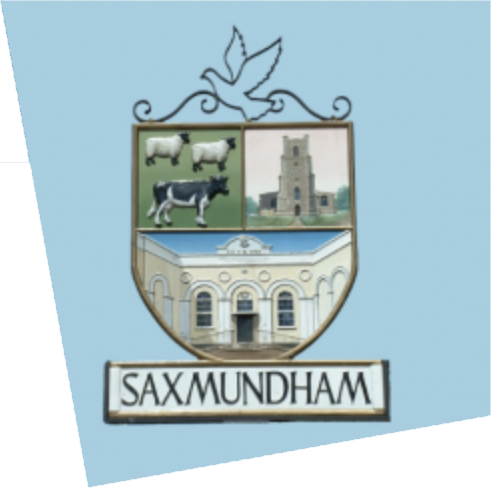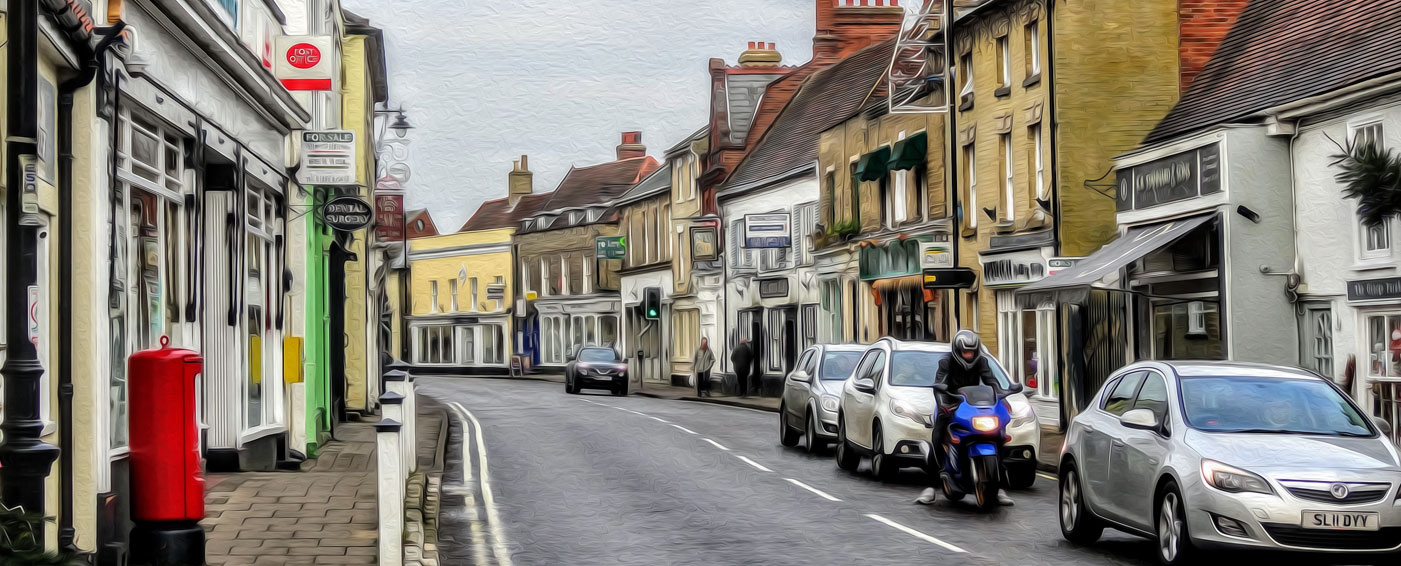
History
"A strange but fascinating mixture of the ancient and the modern.
Such is Saxmundham"
Saxmundham, in a sentence, evolved for centuries largely at its own rhythm, rather than undergoing sharp upheavals or developments that abruptly changed its face or future. The pace of change has quickened more recently, and some may argue that the town now stands before the biggest changes in its history… but that’s another matter.
A French visitor to our town in 1784, looking at improved farming techniques in the area, wrote:
“We made much mileage that day in going over all the farms we knew to be the most considerable, and all that day was spent in the most satisfactory way. The end of the day put a stop to our investigations, and we relaxed at Saxmundham. It is a kind of village, but it is well lived in.”
A kind of village – and later a town – but always “well lived in”; and always, well, a bit relaxed!
Around 1940, a local author wrote:
“One of the great attractions of the English countryside is the way in which our main highways are studded with small town-ships in which one encounters a strange but fascinating mixture of the ancient and the modern. Such is Saxmundham.”
This comes from the ‘Official Guide to Saxmundham’ by J.S Waddell, published by Saxmundham Urban District Council. The picture it paints of the town is truly evocative of the period!
If you want to explore our history in more depth, and with stronger visual impact, a great way is to visit the Saxmundham Museum – a treasure trove for our town’s heritage.
There is also a good ‘Short History of Saxmundham’, written in 2003, by Richard Smith. And if you have time, you can explore the town’s past on foot, around the Town Trail (here, the Museum’s version).
Origins
The name ‘Saxmundham’ has a fine ring to it, but it probably just means the ‘ham’, or settlement, of a Saxon lord named Seaxmund or Seismund. But people lived here even before the Saxons arrived from the 5th century on. There is recent evidence of Bronze Age settlement, as well as early Saxon, on the east side of the River Fromus, whilst the medieval and modern town lies mainly on the west.
The County Council’s Suffolk Heritage website says that “Excavation [in 2015 and 2016] following two phases of evaluation revealed evidence of Bronze Age, Iron Age and Saxon settlement across the site.”
The Early Saxon settlement (including a hall and “sunken feature buildings”) indicates an early 6th Century AD date, and excavation there revealed traces of hand-made pottery, and evidence of “cloth weaving, crop processing, horn-working and antler-working activities”.
The parish church of St John’s also lies on the east side of the river, perhaps reflecting the town’s origins there, and church buildings on the site date back probably to pre-Norman Conquest times. A Saxmundham church is listed in the Domesday Book of 1086, which listed all ‘assets’ from towns and villages across the country, with a view to potential royal taxation. You can find out more about St John’s Church and its history here.
Twin roles
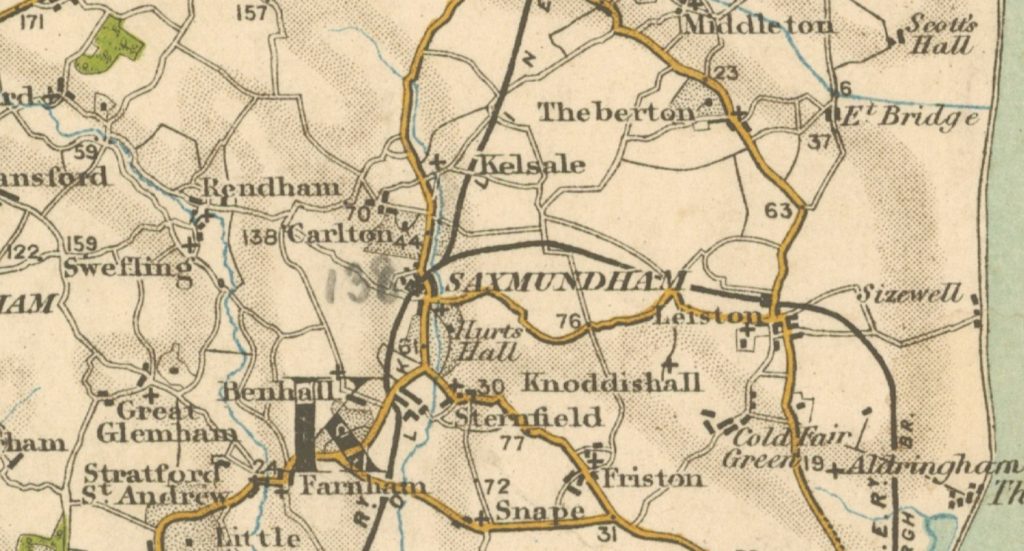
As a town, Saxmundham has, throughout its history, played two overlapping roles. The first is that of market town and “service centre” for the surrounding – mainly agricultural – area. The second role is that of transport hub or link – for centuries, Saxmundham has been an important staging post on the Ipswich to Lowestoft road, as a “thoroughfare town” with coaching houses and inns and places of good entertainment.
Market town
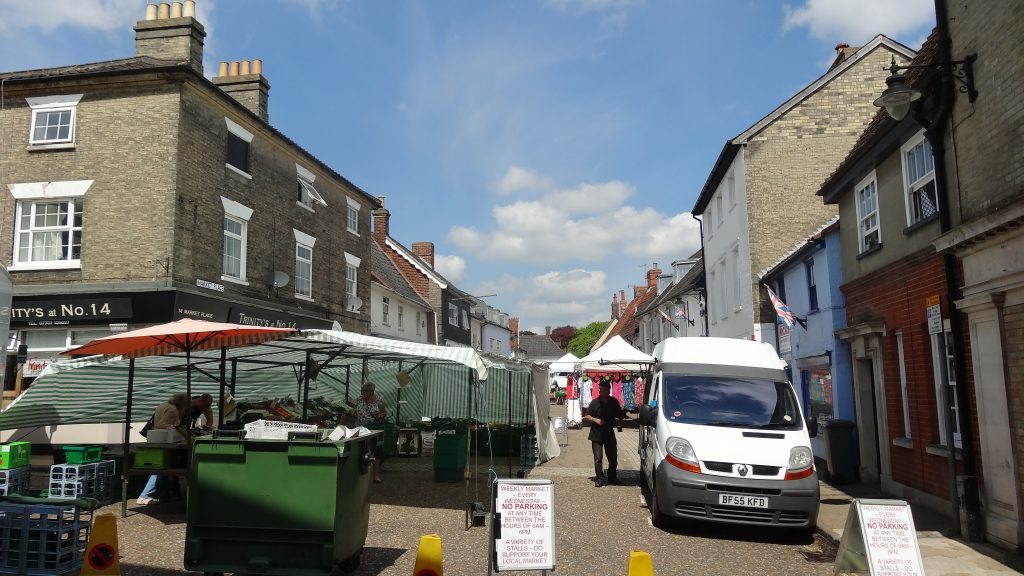
As to the market, Saxmundham’s Charter dates back to 1272, with a grant from Henry III of market and fair to John de Ramseye. This was not the only grant of such charter – in 1311 there was also a Grant of market and fair to Thomas de Verley “to be held on 7 acres in Saxmundham on Ascension Day”, and in 1348, a Grant of fair to Sir John Wingfield to be held on Hurts Hall Manor. (See Suffolk Heritage website here). The town grew up around its market, whose “place” was probably much larger than the present Market Place, until the buildings on its east side became permanent structures.
Saxmundham boasted a fine livestock market until 1977. Even with attempts to revive it, today’s weekly Wednesday market offers but a faint reminder of earlier times. And while Lambsale Meadow performs an essential function today as the site of a doctor’s surgery, its name also evokes a not-so-distant past when fairs and markets played a major role in Saxmundham’s life.
Nor was Saxmundham always a purely local centre for exchange and fairs. For over 100 years, from 1831 – 1939, Saxmundham also hosted the annual Suffolk Show a total of 14 times, often on The Layers, an open space to the immediate south. In those days the Suffolk Show rotated its venue around the county, before taking up permanent residence in Ipswich.
In recent years, the town has played its ‘market’ role in a new way, with two major supermarkets opposite each other off Church Street (Waitrose and Tesco).
Transport hub
Saxmundham has for centuries been on a main road from Ipswich to Lowestoft or Great Yarmouth. It was throughout a significant staging post, a place for refreshment and change of horses. The Bell, an imposing building on High Street, was rebuilt in the early 1840s, probably the last staging inn to be constructed in England. Numerous stagecoaches departed from the Bell or Angel inns, going both south and north.
To try to ensure better maintenance of the road and bridges, the ‘Ipswich to South Town and Bungay Turnpike Trust’ was set up in 1785; the road passed through Saxmundham, which still has a turnpike house at North Entrance. Road users were charged a fee to pass through. The trust was wound up in 1872 (following the arrival of the railway in 1859, its competitor), and in 1889 the new County Council took over responsibility for the highway.
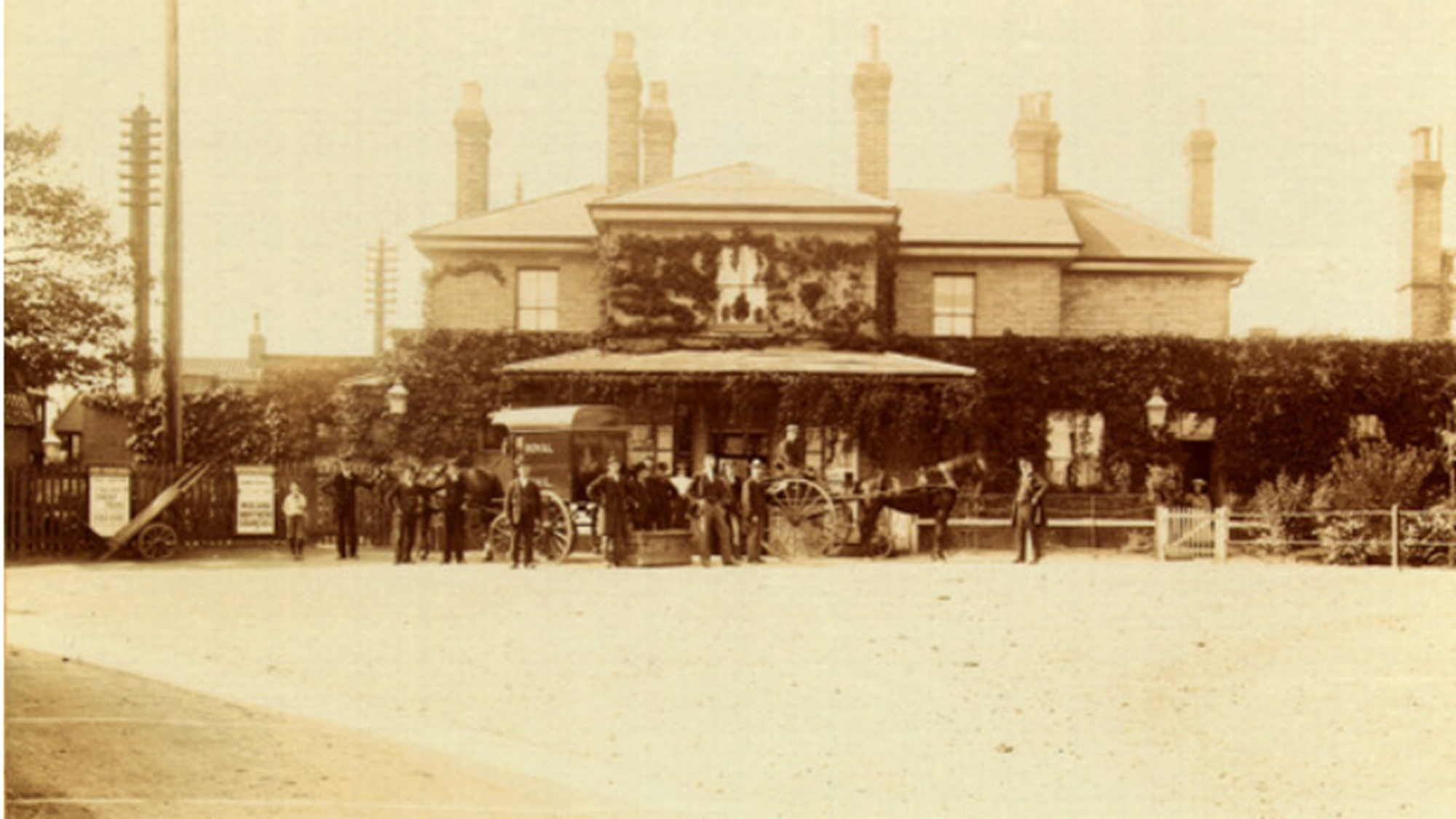
The railway came to town in 1859, when the East Suffolk Line from Ipswich to Yarmouth and Lowestoft was completed. The station building was a major landmark in the town for over 150 years, until a major fire in 2018. It has been rebuilt in 2021 as a single-storey structure but with design echoes of its past. The branch line to Leiston and Aldeburgh also opened in 1859, but was closed as part of the 1960s ‘Beeching cuts’. The rail track to Leiston still exists, potentially for Sizewell C construction material delivery if it proceeds.
In 1988 the A12 Saxmundham by-pass was opened, reducing traffic in the town centre (at least for a few decades) but also reducing some of the town’s economic activity.
The traditional town centre
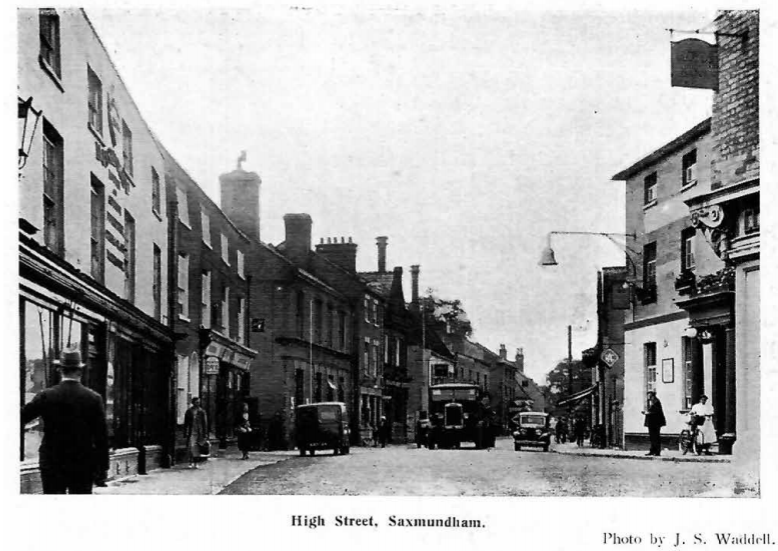
Photo from Official Guide to Saxmundham (1940), acknowledgment to Museum
The main town grew up around the market and the cross-roads between the main Ipswich to Lowestoft route, and the smaller east-west road to Framlingham or Leiston. Some of the oldest buildings are in Chantry Road and South Entrance, with numerous buildings along and around the town centre (including Market Place) dating from the 16th to 18th century. The town centre is very largely contained within the present Conservation Area, for which a good report was made in 2016. This gives information on many interesting individual buildings, with photos. There is also a significant area of 19th century buildings – mainly dwellings but including the Congregational Church – to the immediate west of the centre, and close to the station.
The town trail also offers information on some sites of historic interest.
Although not part of the centre, Hurts Hall (to the south-east of town) has for centuries formed an important part of the town, its name as ‘manor” dating back to the Domesday Book, with successive houses built on the site. The latest dates to 1893, rebuilt following a fire; the house has recently (2021) been restored by its present owner. In his short history of Saxmundham, Richard Smith summarised its role:
“Hurts Hall is a neo-Elizabethan mansion of 1893, rebuilt after the elegant 1803 bow-fronted house by Samuel Wyatt was destroyed by fire in 1890. It was lately the home of the Long family, plantation and slave owners in Jamaica, who were nevertheless squires and benefactors to the town.”
One of the Long family’s contributions (from wealth so accumulated) was the elegant-fronted Market Hall in the High Street, founded in 1846 as a Corn Exchange, and later used as courtroom, drill-hall and public meeting place, as well as market.
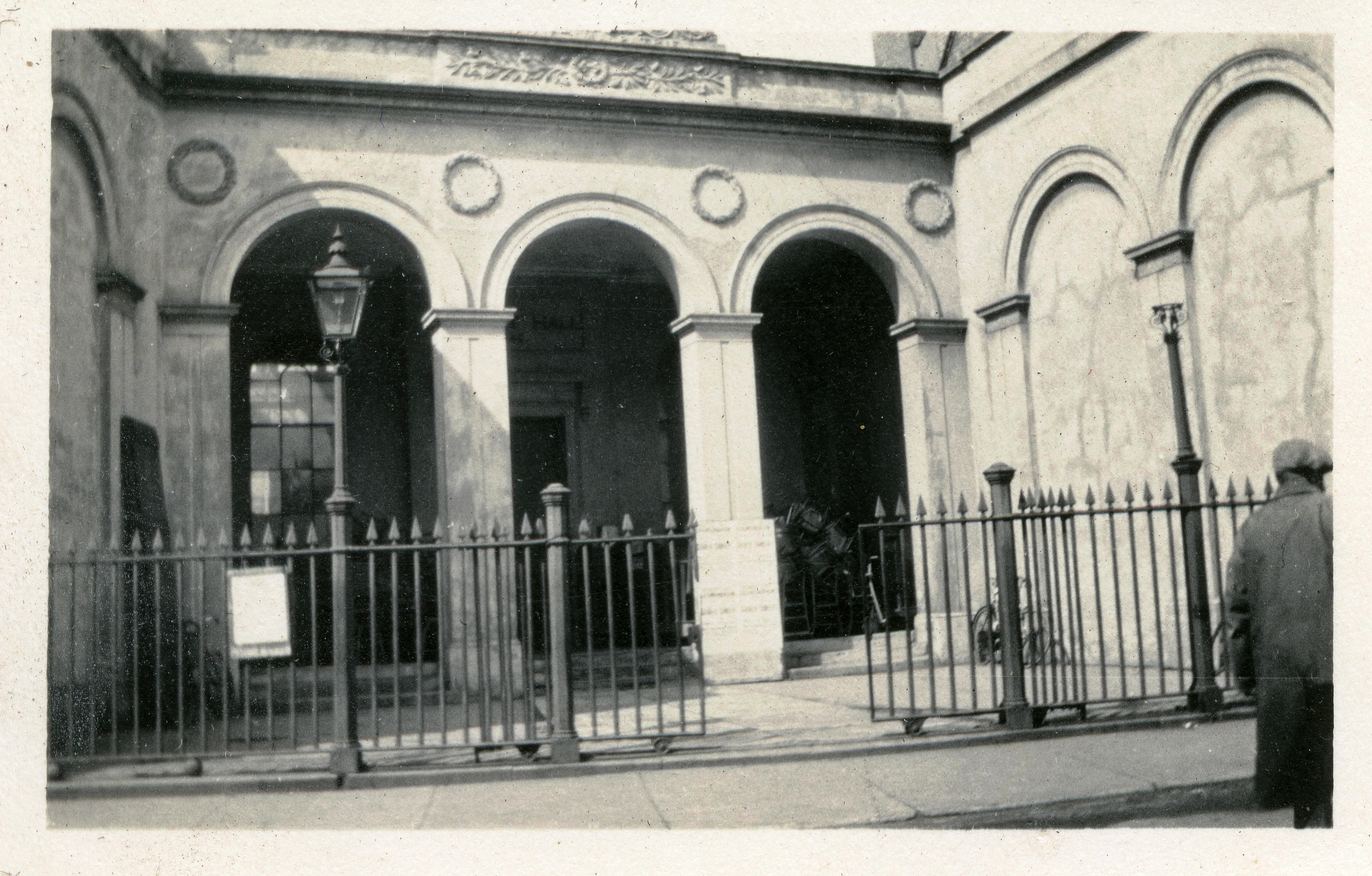
The Hall was transferred in 1920 to Saxmundham Urban District Council (now the Town Council) to hold on trust for use by the local community.
Population
For centuries, the population of Saxmundham could be counted in hundreds. In 1603, at the end of the reign of Queen Elizabeth I, there were just 113 adults recorded; by 1674 there were 96 households, which means a few hundred residents. Since 1801, a national census has been conducted every ten years (save in 1941), so we have more reliable figures to go by.
As the chart below shows, the population of Saxmundham grew at a steady rate for a century from 1801 through to 1901, and then saw some ups and downs in the first half of the 20th century. From 1950 it started to grow again, and from around 1980 has rapidly expanded.
In the 19th century, and much of the 20th, the rural population of Suffolk tended to diminish, but Saxmundham bucked that trend. In a study of East Suffolk rural change from 1850 to 1939, the author finds:
“The largest among several market towns was Woodbridge, with a population in 1851 of 5,161 falling to 4,734 in 1931. Of the other four market towns, Framlingham, Halesworth, Saxmundham and Wickham Market, only Halesworth had a population greater than 2,500 in 1851 (2,662), and only Saxmundham showed an overall increase in population over the whole period, of nearly twenty-two per cent. In contrast, the coastal towns of Southwold, Aldeburgh and Felixstowe expanded, reflecting their growing popularity as holiday and seaside resorts.”
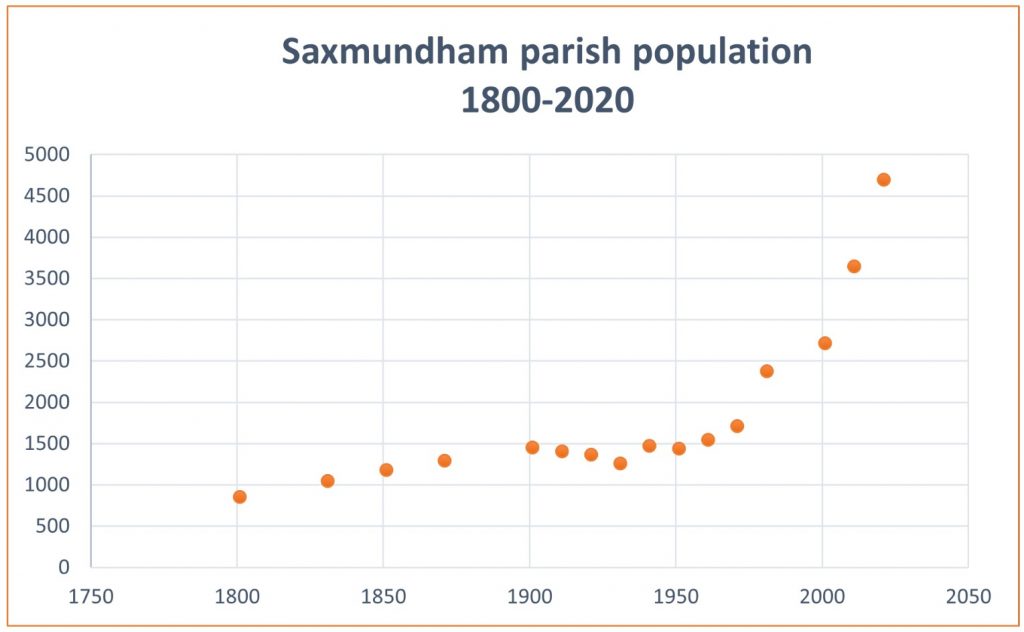
(All data are from the respective censuses, from 1801, other than for 1941 which is here a 1939 figure, and for 2021, where we use Office for National Statistics estimated population data for 2019)
The period since 1980 has seen the building of new housing estates – first, the Brook Farm Estate, to the west and north-west, and more recently, to the west but south of Rendham Road, and – to the east – the Hopkins estate. A South Saxmundham Garden Neighbourhood is included in the District Council’s Local Plan for the area, which would add around 2,200 to the population of the town (though much of it may be in Benhall parish)
Employment in Saxmundham
There is no space to analyse the changes in Saxmundham’s workforce over centuries, but this list of trades and crafts in 1844 (from Suffolk Heritage Explorer) paints a nice picture of the town’s life at that time:
“Post office, gardener/seedsman, gunmaker/game dealer, glove maker/glass dealer, cooper, cart owner, bookseller, police officer, bank agent, basket maker, currier/leather cutter, dyer, 2 farmers, tanner, 2 watchmakers, sheriff’s officer, attorney’s clerk, book−keeper, farm bailiff, bricklayer, coachmaker, upholstress, 3 gardeners, farrier/cow leech, land surveyor, auctioneer, cowkeeper, beerseller, fishmonger, corn miller/merchant, 2 bankers, 5 fire and life agents, 5 inns/taverns, 6 academics, 3 attorneys, 3 bakers/confectioners, 2 blacksmiths, 7 boot/shoemakers, 2 brazier/tinners, 2 brewers, 3 butchers, 3 cabinet makers, 2 chemist/druggists, 4 grocer/drapers, 3 laundresses, 2 ironmongers, 2 joiners, 4 milliners, 2 painters/plumber/glaziers, 2 saddlers, 2 shopkeepers, 2 stone masons, 4 straw hat makers, 4 surgeons, 3 tailor/drapers, 2 whitesmiths, 3 wine/spirit merchants”
From Poor Law to Local Government
Towns need to be cared for, developed and maintained. Residents need basic services to be provided. Roads, water, public health, looking after the poor, crime and security… But until the 19th century, the picture was complex as to who was responsible for what. The 1601 Elizabethan Poor Law had made each parish responsible for poor relief. According to a Parliamentary report in 1777, Saxmundham had a parish workhouse with accommodation for up to 60 inmates. This was situated along Rendham Road, not far from the Memorial Field today. Under the harsh New Poor Law Act of 1834, Poor Law responsibilities were given to the new Plomesgate Union, covering a wide area including Framlingham and Aldeburgh as well as Saxmundham. (Plomesgate was the name of one of the ancient “hundreds”, or divisions, of the county). A large new workhouse was built in Wickham Market – in the 1881 census, 4 out of 123 inmates were from Saxmundham, including a 5 year old boy.
In 1894, a new Plomesgate Rural District Council was formed in much the same area, which included Saxmundham until 1900, when Saxmundham Urban District Council (UDC) was carved out of it, to form a new unit of local self-government. The UDC managed many local services for the town, until it was in turn swept away in the reform of 1974. Its responsibilities were transferred in part to the new Suffolk Coastal District Council, and in lesser part to the Saxmundham Town Council.
In his ‘Official Guide to Saxmundham’ (published 1940), J.S Waddell said this of the UDC
“Thanks to a sympathetic, as well as progressive, Urban District Council, things ancient are well looked after and every opportunity seized to extend the modern. As an example, since 1934 [no] fewer than forty-eight Council houses have been erected, besides twelve by private enterprise and six by the Oddfellows Friendly Society…” [Editor: we assume the word ‘no’ was meant!]
Perhaps we should note, alongside these warm words, that the Guide was written for the UDC!
Since 1974, the Town Council (which is a parish council) owns and runs the Memorial Field, two playgrounds and the Market Hall, while most other local government tasks are divided between the county council (e.g. highways, social services, libraries) and the district council (e.g. planning, economic development, housing, waste collection and environmental services). The Town Council also supports local events and activities, and makes small grants to local voluntary bodies. It acts as the voice of the local community towards other levels of government and organisations on matters affecting the town.

